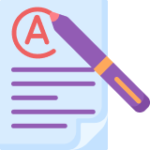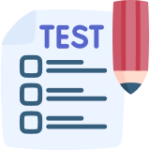Elevate Your Educational Assessments
Empower Learning with
Bloom s Taxonomy
Welcome to the future of educational assessment, where Bloom's Taxonomy integrates seamlessly into your testing and grading systems. Our platform is designed to revolutionize the way you create tests, manage questions, and analyse student performance, all through the lens of Bloom's Taxonomy. Discover a comprehensive approach to evaluating cognitive skills and knowledge, tailored to each class group and educational need.
Comprehensive Cognitive Skill Assessment
Remember (RE)
Assessments begin with evaluating the ability to recall facts and basic concepts, laying the groundwork for deeper cognitive engagement.
Understand (UN)
Moving beyond mere memorization, questions at this level test comprehension, including interpreting, exemplifying, classifying, summarizing, inferring, comparing, and explaining materials.
Apply (AP)
At this stage, students are asked to use information in new situations, demonstrating the application of knowledge through exercises, simulations, or creative tasks.
Analyze (AN)
Assessments delve into the analysis, where students break down information into components to understand structures, relationships, and ideas. This level challenges learners to differentiate, organize, and attribute concepts.
Evaluate (EV)
Higher up the hierarchy, students engage in critiquing based on criteria and standards. They are encouraged to judge, test, and defend opinions, reflecting on the validity and reliability of information.
Create (CR)
At the pinnacle of Bloom's Taxonomy, learners are tasked with producing original work. This might involve designing, assembling, constructing, conjecturing, developing, formulating, authoring, or inventing based on acquired knowledge and analytical skills.
Tailored Assessments for Diverse Learning Paths
By mapping each question to a specific level within Bloom's Taxonomy, our platform enables educators to craft nuanced tests that accurately reflect the intended learning outcomes. This meticulous approach ensures that assessments are not just about measuring knowledge but are a tool for fostering and evaluating critical thinking, problem solving, and creative skills.
Dynamic and Flexible Test Creation
Our platform's flexibility allows for the dynamic allocation of questions tailored to the specific cognitive goals of each class group. Educators can design tests that focus on one or more levels of Bloom's Taxonomy, depending on the curriculum objectives and the developmental stage of their students. This adaptability ensures that assessments are aligned with educational goals, promoting a deeper, more meaningful learning experience.
The Impact of Bloom s Taxonomy on Educational Assessment
Integrating Bloom's Taxonomy into test creation transforms the assessment process from a unidimensional task into a multi faceted educational tool. It shifts the focus from rote memorization to a more holistic evaluation of a student's learning journey, encouraging the development of a broad range of cognitive skills. Through this approach, educators can foster an environment that values and cultivates higher order thinking, creativity, and lifelong learning.
How It Works:
1. Customizable Tests
With our platform, educators can construct tests specifically tailored to their class groups, with a flexible number of questions across each level of Bloom's Taxonomy. This customization ensures that each test can accurately measure the intended cognitive skills and knowledge areas.
2. Skill Mapping & Max Marks
Each question can be assigned a maximum mark and mapped to specific cognitive skills within Bloom's Taxonomy. This mapping guarantees that the assessment is balanced, covering a range of abilities from basic understanding to creative application.
3. Dynamic Question Allocation
To cater to diverse learning groups, questions are dynamically allocated based on the class group each student belongs to. This means that each student receives a personalized testing experience that is aligned with their learning path and objectives.
Elaborating on the Example: Customized Bloom s Taxonomy Tests
This expanded example explores how tests can be customized for two distinct class groups, Blue and Red, each with a maximum score of 20. This customization allows educators to cater assessments specifically to each group's developmental needs and learning objectives, leveraging Bloom's Taxonomy to foster a broad spectrum of cognitive skills.
1. Class Group Blue: Focusing on Create and Analyze
For Class Group Blue, the test is designed to challenge students with tasks that stimulate higher order thinking skills, specifically in the 'Create' and 'Analyze' domains of Bloom's Taxonomy.
Creating New Ideas
Questions aimed at the 'Create' level might ask students to design a science experiment to test a hypothesis or write a short story based on a given theme. These tasks require students to synthesize knowledge and apply it in innovative ways, pushing them to draw on their understanding and analytical skills to produce something new.
Analyzing Information
The 'Analyze' portion could include questions that present students with a complex problem solving scenario or a data set to interpret. For example, they might be asked to examine a case study and identify the underlying principles that govern the observed outcomes or to dissect a piece of artwork and discuss its use of color to convey emotion.
The distribution of questions ensures that the total marks allocated for 'Create' and 'Analyze' tasks equal 20, providing a balanced assessment that encourages students to engage deeply with the material and apply their learning creatively and analytically.
2. Class Group Red: Dnhancing Remember and Understand
For Class Group Red, the emphasis shifts towards foundational cognitive skills: 'Remember' and 'Understand'. This approach is tailored to solidify the students' grasp of basic concepts and enhance their comprehension skills.
Recalling Facts
Remember' questions could be straightforward queries asking for specific factual answers, such as the dates of important historical events, the definition of scientific terms, or the identification of key figures in a literary work. This segment tests students' ability to retrieve and recall information accurately.
Understanding Concepts
'Moving to the 'Understand' level, questions might involve explaining concepts in their own words, summarizing the themes of a narrative, or interpreting the implications of a scientific theory. These tasks require a deeper engagement with the material, pushing students to demonstrate their comprehension and ability to interpret information in a meaningful way.
By designing the test with 5 questions that equal to 20 marks, educators can ensure a focused assessment of foundational knowledge and comprehension abilities. This methodical approach allows students in Class Group Red to strengthen their understanding and recall of the subject matter, building a solid foundation for more complex cognitive tasks.
Seamless Integration and Easy Access
Upon entering marks, educators can update the data to the main results page directly, facilitating a smooth transition from assessment to analysis. Our platform's design is intuitive, ensuring educators can navigate the test creation, management, and analysis process with ease, all while leveraging the power of Bloom's Taxonomy to enhance educational outcomes.























































